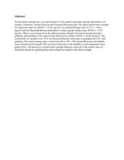| dc.contributor.author | Opinya Gladys N. | |
| dc.contributor.author | Pameijer, CH | |
| dc.date.accessioned | 2013-06-18T15:01:21Z | |
| dc.date.available | 2013-06-18T15:01:21Z | |
| dc.date.issued | 1986 | |
| dc.identifier.citation | Int Dent J. 1986 Dec;36(4):225-9. | en |
| dc.identifier.uri | http://www.ncbi.nlm.nih.gov/pubmed/3542838 | |
| dc.identifier.uri | http://erepository.uonbi.ac.ke:8080/xmlui/handle/123456789/35850 | |
| dc.description.abstract | Tensile bond strength tests were performed on 120 enamel specimens equally distributed over 'normal' American, 'normal' Kenyan and fluorosed Kenyan teeth. The mean tensile bond strength for American teeth was 59.08 +/- 15.81 kg/cm2, for normal Kenyan teeth 41.52 +/- 14.64 kg/cm2 and for fluorosed Kenyan teeth prior to removing the surface layer 49.20 +/- 17.67 kg/cm2. There was an increase in the adhesive bond strength for fluorosed teeth after first grinding and polishing with a green stone followed by pumice (58.84 +/- 20.65 kg/cm2). The coefficients of variation were 27% for fluorosed Kenyan teeth prior to grinding and 35% after grinding. The tested etching times varied from 60 to 150 s. The normal Kenyan teeth had the lowest tensile bond strength. This may have been due to the inability to etch adequately these teeth in 60 s. The increase in tensile bond strength indicates removal of the surface layer of fluorosed enamel by grinding then acid etching may improve the bond strength. | en |
| dc.language.iso | en | en |
| dc.title | Tensile bond strength of fluorosed Kenyan teeth using the acid etch technique. | en |
| dc.type | Article | en |
| local.publisher | Department of Dental Surgery, College of Health Sciences University of Nairobi | en |

